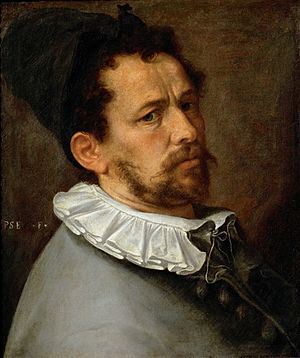Bartholomeus Spranger facts for kids
Bartholomeus Spranger (born March 21, 1546, in Antwerp; died 1611, in Prague) was a talented Flemish artist. He was a painter, draughtsman (someone who draws), sculptor, and even designed pictures for prints. He worked for the Holy Roman Emperor Rudolf II in Prague. Spranger developed a special art style called Northern Mannerism, which was very popular at the time.
His unique style mixed ideas from Dutch painting with Italian art, especially from the Roman Mannerists. This made his work very important and influenced many other artists. His paintings became well-known across Europe through prints.
Contents
Life Story
Bartholomeus Spranger was born in Antwerp. He was the third son of Ioachim Spranger and Anna Roelandtsinne. His father was a trader who had traveled a lot, including a long stay in Rome.
Bartholomeus loved drawing from a young age. He first became an apprentice (a student learning a trade) to Jan Mandijn for 18 months. After Mandijn passed away, Spranger studied with Frans Mostaert, but Mostaert also died soon after. Finally, he studied with Cornelis van Dalem for two years and then stayed in van Dalem's workshop for two more years. His teachers were mostly landscape painters. Spranger also copied prints by famous artists like Frans Floris and Parmigianino to learn more.
He traveled to Paris in 1565 and worked there for six weeks. Then he went to Italy. He stayed in Milan for eight months. After that, he worked in Parma for three months, helping Bernardino Gatti paint the dome of the Santa Maria della Steccata church.
In Rome, he worked on wall paintings in different churches. He became a protégé (someone who is helped and guided by an older, more experienced person) of Giulio Clovio. In Rome, he also met Karel van Mander, who later wrote about Spranger in his book Schilder-boeck. This book, published in 1604, included stories about important Dutch painters. In 1570, Pope Pius V made him a court painter. This meant he painted for the Pope.
Later, Emperor Maximilian II asked him to come to Vienna. However, Maximilian II died shortly after Spranger arrived in 1576.
Maximilian II's successor, Rudolf II, really wanted Spranger to work for him. In 1581, Rudolf II appointed Spranger as his court painter and also his valet de chambre (a personal attendant). The emperor's court had moved to Prague, and Spranger stayed there until he died in 1611. He lived in a house just outside the castle walls.
Spranger became very close friends with Emperor Rudolf II. They spent many days talking, and the emperor often visited Spranger's art studio. Rudolf II gave Spranger a special title in 1588 and a noble title in 1595. Because of the emperor's support, Spranger became very wealthy and owned many properties.
One of Spranger's paintings, ', shows Bellona (the Roman goddess of war) on a globe. She is surrounded by other gods and symbols of Hungary and the Croatian river Sava. This painting was a type of propaganda, meaning it was meant to show that the empire was safe and strong with Rudolf as its leader.
In 1582, Spranger married Christina Müller, whose father was a rich jeweler from Prague. Sadly, his wife died in 1600 after all their children had passed away. This sad event is shown in Aegidius Sadeler's '.
His Artworks
Spranger's paintings are some of the best examples of the final stage of Northern Mannerism. The largest collection of his works is in Vienna. His drawings are known for their great energy and free style.
Spranger also worked as a sculptor. He might have learned about sculpture from Hans Mont, another Flemish sculptor who worked at the Prague court. After Mont left, Spranger seems to have made sculptures for the emperor from time to time. A terracotta (baked clay) relief called 'Body of Christ Supported by an Angel' is believed to be by him. The Walters Museum has a bronze sculpture called 'Achelous and Deianeira' that is also thought to be his work.
Artists like Aegidius Sadeler and Hendrik Goltzius made engravings (prints) of Spranger's paintings. This helped spread Spranger's fame all over Europe.
Art Collections
The best collection of Spranger's work is at the Kunsthistorisches Museum in Vienna. Most of these pieces came from the emperor's own collection. Many museum print rooms also have examples of his prints. For example, the British Museum featured his work in a 2022 exhibition about art from Rudolf II's court.
The Blanton Art Museum in Austin, Texas, has three of his oil paintings: Saint Catherine, Saint Ursula, and Saint Margaret. You can also find his Memento mori in the Wawel Castle Museum in Cracow, Poland, and the Epitaph of Nicolas Müller, Goldsmith of Prague in the National Gallery Prague.
See also
 In Spanish: Bartholomeus Spranger para niños
In Spanish: Bartholomeus Spranger para niños


